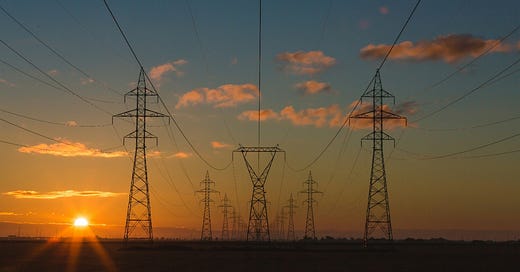Climate Tech Venture Updates for February 27, 2025
Big news from Energy Vault (NRGV) for data center battery backup, Regenified goes global with help from Waitrose, and OhmConnect connects the dots to become Renew Home
Energy Vault
Readers may recall Energy Vault from my overview of its core energy storage solutions. As I wrote in my 2022 article We Have an Energy Storage Problem and my comprehensive series of articles on the technical capabilities and broader sociopolitical considerations of Energy Vault’s gravity storage, the company continues to innovate in critical energy storage solutions.
In December, the company announced a partnership with RackScale Data Centers to provide 2GW of primary power to RSDC's data centers using a newly designed battery energy storage system called the B-Nest.
The B-Nest is a multi-story battery solution which Energy Vault says offers eight times the energy density of standard battery solutions, providing data centers with full primary power for 10+ hours. I spoke with Marco Terruzzin, Chief Commercial and Product Officer at Energy Vault, about the design, and I am really impressed by how the company allows data centers to get up and running faster without incurring grid congestion. I’ll be writing more about B-Nest in an upcoming article.
In January, Energy Vault announced another partnership with NuCube Energy, again targeting the AI data center market. NuCube's technology delivers continuous zero-carbon power through small nuclear reactors that can operate for years without refueling, with safety features that can contain any potential emergency zone within a reactor building. The partnership aims to serve the U.S. data center market's projected 500 TWh consumption (which will require 60GW of power generation) by 2028.
I had not heard of NuCube before, but I plan to discuss the firm’s offerings with its founder after doing some background research. Terruzzin described the founder as “absolutely world-class” so I’m looking forward to meeting and speaking with him.
Regenified and Waitrose
Some of you may recall Regenified from my previous article, Regenified Is Creating the Framework We Need to Save the Planet, in which I discussed its work in regenerative agriculture, as well as Conventional Farming Is Killing Us and Our Planet, which highlighted the environmental damage caused by conventional farming.
Recently, the company—co-founded by Gabe Brown, featured in the documentary Kiss the Ground—revealed in its 2024 Consumer Trends Report a significant shift in consumer interest in and demand for regenerative agricultural products.
Regenified surveyed 850 U.S. consumers and found a significant shift in shopping priorities towards regeneratively grown food, with interesting data evidencing nuances on purchasing preferences, price sensitivity, and product availability challenges.
Last year, Regenified's CEO, Salar Shemirani, crossed the Atlantic with Brown to speak about the importance of regenerative agriculture at a laboratory farm for Waitrose, a leading employee-owned supermarket chain in the UK.
Waitrose is very forward-thinking—so much so I could hardly believe the difference between it and U.S. chains when I spoke with Jake Pickering, Waitrose’s Head of Agriculture, Aquaculture and Fisheries. For example, Waitrose has announced a commitment to source all meat, eggs, milk, fruit, and vegetables from regenerative farms by 2035 as part of the firm’s Linking Environment And Farming (LEAF) program.
Pickering told me that his firm was concerned with the long-term economic viability of the farmers growing the food it sells, and has set aside financial and educational resources to support over 2,000 British farmers as their farms transition to regenerative practices by 2035.
The company aims to achieve net zero emissions on its UK farms by 2035 and across its entire supply chain by 2050.
OhmConnect
Readers will remember that in September 2022, I wrote that OhmConnect’s Virtual Power Plant (VPP) played a crucial role in helping California avert rolling blackouts during a historic heat emergency. To learn what a VPP is, see the video below.
OhmConnect’s success in several regional markets led to a big expansion with its partnership with Google’s Nest Renew business. In May of last year, Google spun out Nest Renew to OhmConnect investor Sidewalk Infrastructure Partners, which invested $100 million in the formation of Renew Home, now North America's largest residential virtual power plant.
OhmConnect’s platform had grown to nearly a quarter of a million homes in California, Texas, and New York. Nest Renew controlled nearly 3 gigawatts of electrical energy use with a user base in the millions at the time of the merger, and Renew Home thinks it can expand to a 50GW footprint by 2030.
VPPs are a big priority for the Department of Energy, which expects a 3x increase in the number of homes and businesses participating in VPPs by 2030 to allow the U.S. to avoid $10 billion in grid upgrade costs while meeting 10-20% of peak electricity demand.
I suspected that Google might siphon off data on Nest device usage, but Renew Home's CEO, Ben Brown, told me that Google does not have access to Nest data, and that the platform is designed to integrate with a wide range of smart home devices by manufacturers such as LG, Rheem, Honeywell, and SunPower.
The company has established partnerships with over 100 utilities across the United States, aggregating distributed energy resources such as rooftop solar systems, electric vehicles, and smart building technologies to efficiently balance electricity demand and supply.
I have been talking with the founder of another innovative device manufacturer that is entering the VPP market in a surprising way. We will have more about that company soon. Follow us on Substack, LinkedIn, Twitter, BlueSky, and Facebook and be the first to know when we publish a new article.








